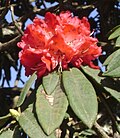| Rhododendron subg. Pentanthera | |
|---|---|
 | |
| Rhododendron luteum | |
| Scientific classification | |
| Kingdom: | Plantae |
| Clade: | Tracheophytes |
| Clade: | Angiosperms |
| Clade: | Eudicots |
| Clade: | Asterids |
| Order: | Ericales |
| Family: | Ericaceae |
| Genus: | Rhododendron |
| Subgenus: | Rhododendron subg. Pentanthera G.Don Gen. Syst. III. 846 (1834) |
| Sections | |
See text | |
Rhododendron subgenus Pentanthera was a subgenus of the genus Rhododendron . The common name azalea is applied to many of the species, and also to species in some other subgenera. [1] In 2005 it was discontinued and its four sections moved or dismembered. [2]
The subgenus included four sections:
- Rhododendron sect. Pentanthera
- Rhododendron sect. Rhodora
- Rhododendron sect. Sciadorhodion
- Rhododendron sect. Viscidula
